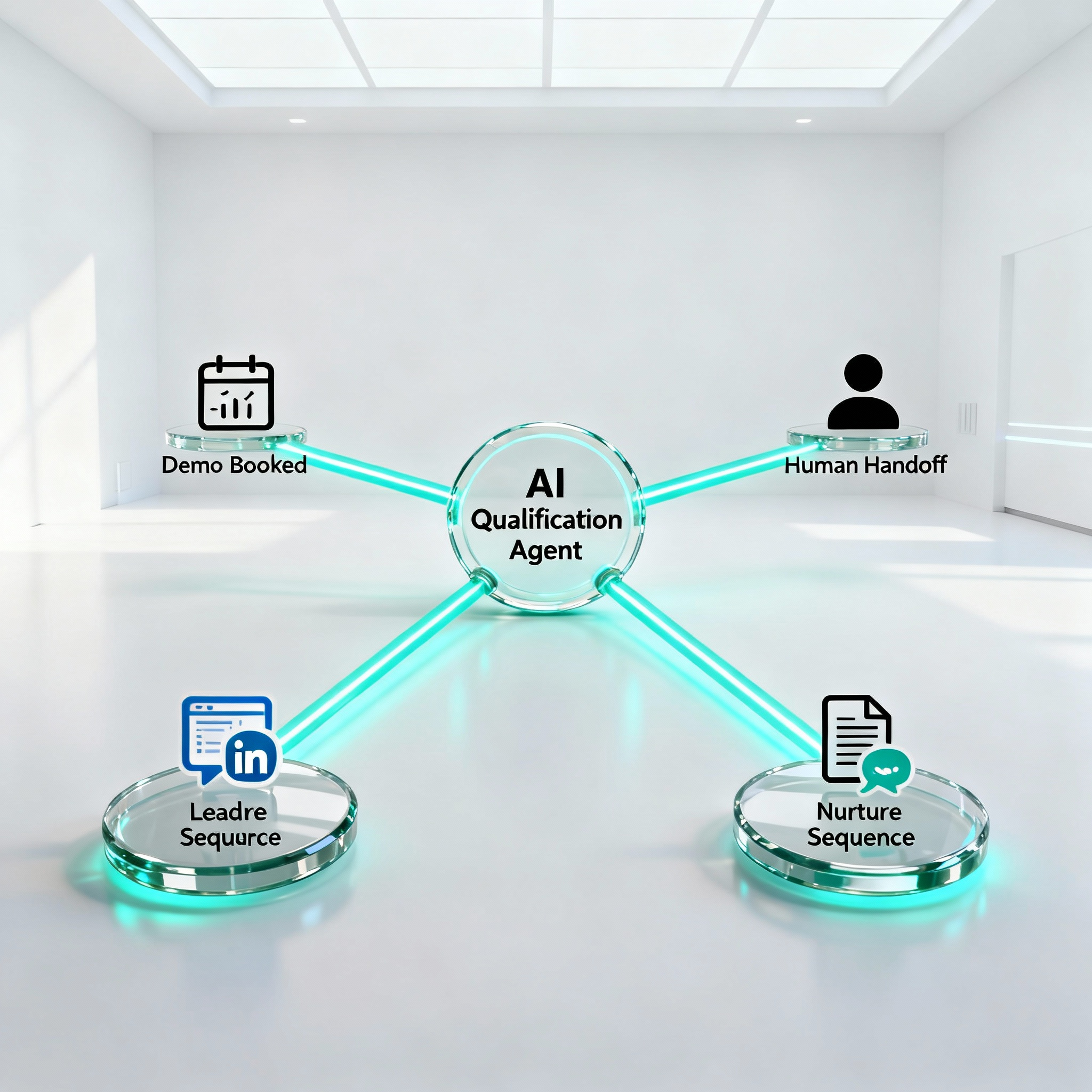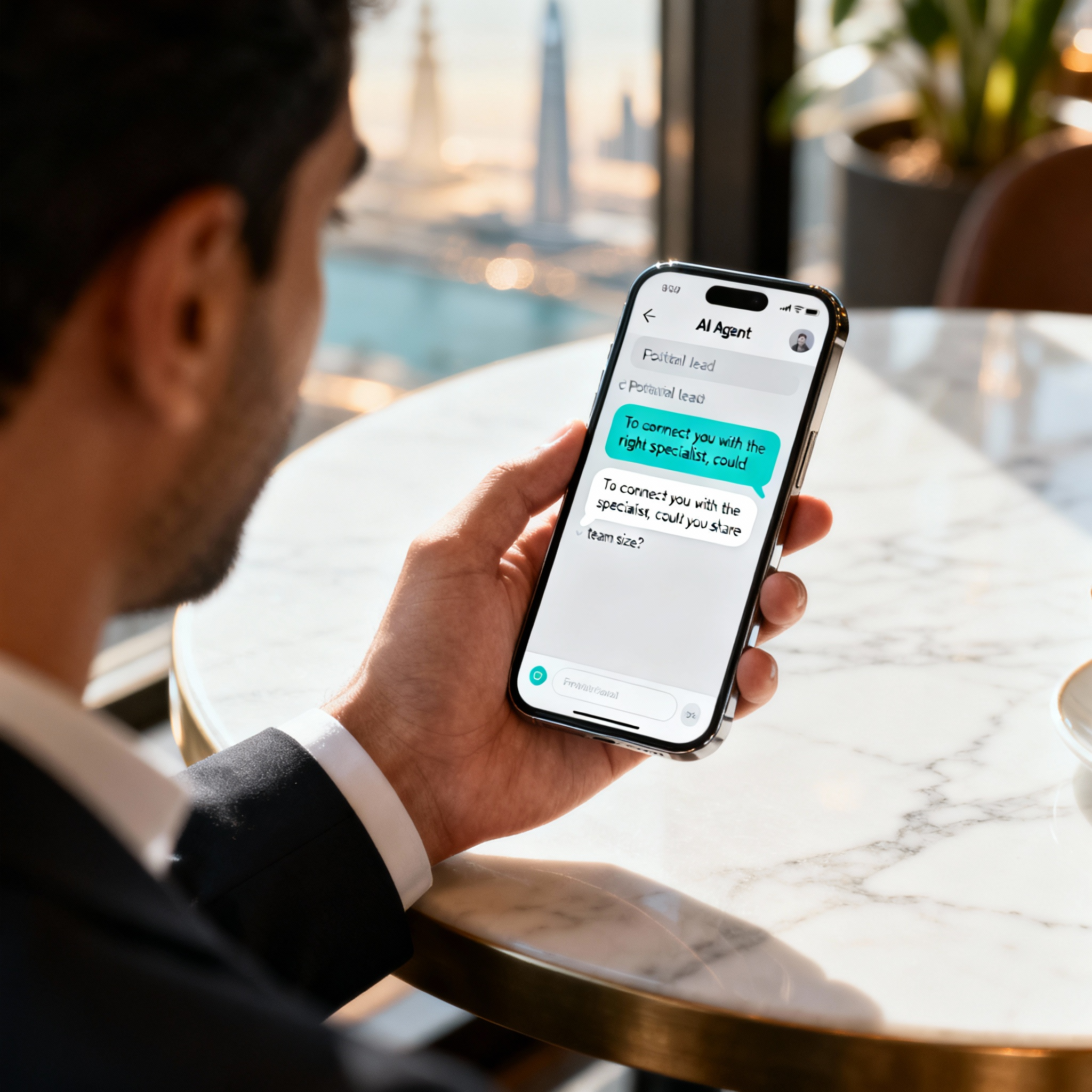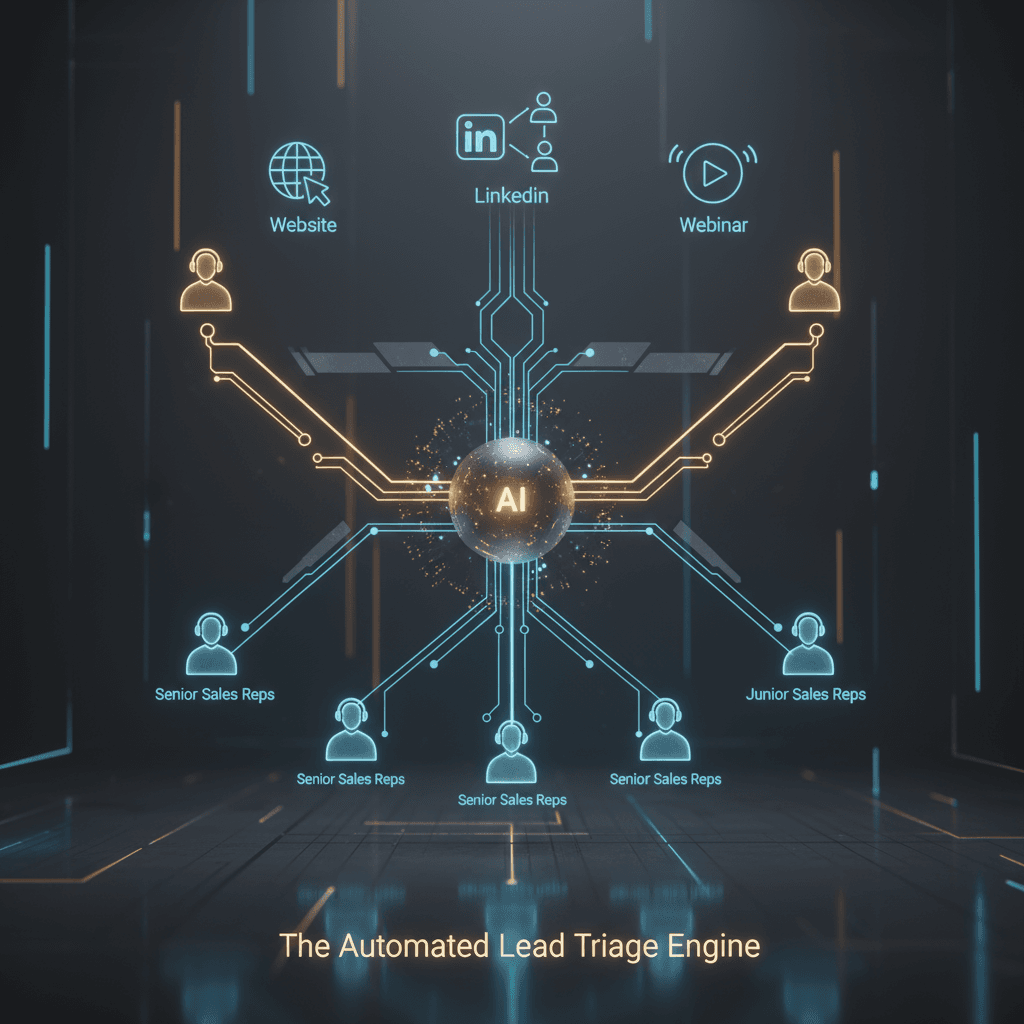How to Use AI Agents for 24/7 Lead Qualification and Booking
Your sales team is likely wasting hours on unqualified leads and manual data entry. This guide provides a step-by-step framework to deploy an AI agent that qualifies leads, books demos, and syncs to your CRM automatically, freeing up your team to focus solely on closing deals.
Your sales reps are spending too much time on tasks that don't involve selling. They're chasing down low-intent leads, manually entering data into the CRM, and wrestling with calendars to book meetings. This guide gives you a practical framework to deploy an AI agent that handles 100% of initial lead qualification and booking, freeing up your team to focus on high-value conversations and closing deals.
Key Takeaways: What an AI Qualification Agent Delivers
- Respond to Inbound Leads in Seconds, 24/7: Capture lead interest at its peak. An AI agent engages website, social, or ad traffic instantly, which can increase conversion by over 50%.
- Increase Qualified Demos Booked: By asking the right questions every single time, the agent triages junk leads and only books meetings with prospects who fit your Ideal Customer Profile (ICP), leading to a higher demo-to-close rate.
- Cut Lead Management Costs: Automate the repetitive work of a Sales Development Representative (SDR) without the associated salary, commission, and overhead.
- Achieve Perfect CRM Hygiene: Every interaction, qualification detail, and meeting confirmation is automatically logged in your CRM, creating a perfect data trail for forecasting and reporting.
- Free Up Your Sales Team: We’ve seen teams reclaim over 10 hours per sales rep per week. That’s time they can re-invest into pipeline acceleration and closing revenue.

The 5-Step Framework to Deploy Your First AI Sales Agent
Building an effective AI agent isn't about complex code; it's about clear logic. Follow these five steps to structure, build, and launch an agent that delivers real pipeline value.
Step 1: Define Your Qualification Criteria
You can't automate what you haven't defined. Your AI agent needs to know exactly what makes a lead "good." Start by documenting your criteria. Most teams use a variation of the BANT framework (Budget, Authority, Need, Timeline), but get more specific.
| Criteria | Example Questions for the AI Agent | Action |
|---|---|---|
| Industry | "What industry is your business in?" | Disqualify if not in target sectors (e.g., e-commerce, SaaS). |
| Company Size | "How many employees are on your team?" | Route to enterprise team if >500; route to SMB if <500. |
| Role/Authority | "What is your role? Are you the decision-maker for this?" | Prioritize VPs, Directors, and C-level titles. |
| Key Problem | "What challenge are you hoping to solve with a solution like ours?" | Triage based on alignment with your core value props. |
| Timeline | "When are you looking to implement a solution?" | Flag leads with a timeline of <3 months for immediate follow-up. |
Step 2: Map Your Lead Sources and Channels
Where will the agent operate? Identify every channel where prospects first engage with you. The goal is to deploy the agent at the earliest possible touchpoint to ensure no lead goes cold.
- Website Forms: The most common starting point. The agent can trigger an email or SMS the second a "Contact Us" or "Demo Request" form is submitted.
- LinkedIn/Social Media: When someone messages your company page or a key executive, the agent can handle the initial engagement.
- Live Chat: Replace a basic, passive chatbot with a proactive AI agent that doesn't just answer questions but actively qualifies the visitor.
- Webinar/Event Registrations: The agent can follow up with every attendee post-event to qualify their interest and book next steps.
Step 3: Design the Conversation Flow
This is where you script the agent’s personality and logic. It should be helpful and conversational, not robotic. The goal is to gather information without friction.
A typical flow looks like this:
- Instant Greeting: "Hi [First Name], thanks for reaching out to Future & Happiness. I can help get you to the right person. To start, what's your company website?"
- Qualification Questions: Ask the questions you defined in Step 1, one at a time.
- Triage & Action: Based on the answers, the agent decides the next step.
- Qualified: "Great, it sounds like we can definitely help. I can book a 15-minute call with our specialist, Sara. Are you free tomorrow at 10:00 AM or 2:00 PM?"
- Not Qualified: "Thanks for the information. Based on what you've shared, it doesn't look like we're the right fit right now, but we'll keep you in mind. Here are some resources you might find helpful."
- Needs Human Review: "That's an interesting question. Let me get a human colleague to jump in here. They'll be in touch via email within the hour."

Step 4: Integrate with Your Sales and Marketing Stack
For an agent to be truly useful, it must connect to your existing tools. This is not optional. Key integrations include:
- CRM (HubSpot, Salesforce, etc.): To log all conversations, update lead statuses, and create new contact records. This is critical for reporting and ROI tracking. For example, we integrated an agent with a client's HubSpot, which immediately tagged MQLs and assigned them, resulting in demo bookings increasing by 22% in 30 days because the human follow-up was perfectly sequenced.
- Calendar (Google Calendar, Microsoft 365): To check sales reps' real-time availability and book meetings directly, avoiding all back-and-forth scheduling.
- Communication Channels (Email, SMS, WhatsApp): To meet your customers where they are. In the UAE, WhatsApp integration is particularly effective for high-engagement conversations.
Step 5: Test, Monitor, and Iterate
Start small. Deploy the agent on a single, lower-traffic web page first. Monitor every conversation to identify where it gets stuck or where prospects drop off. Refine the scripts based on real-world interactions. Once it’s consistently qualifying and booking leads correctly, roll it out to your other channels. To learn more about this process, read our guide on how to build an AI workforce.
Frequently Asked Questions (FAQ)
- 1. How does the AI know if a lead is truly qualified?
- It operates on the rules you provide. The agent uses a scoring system based on the prospect's answers to your predefined questions (from Step 1). If a lead meets the threshold—for example, they are a decision-maker in a target industry with an active need—they are marked as qualified.
- 2. Can the AI handle different languages, like Arabic?
- Yes. Modern language models can be configured to communicate fluently in multiple languages, including Gulf-dialect Arabic. The agent can detect the prospect's language and respond accordingly, which is essential for businesses operating in the UAE.
- 3. What happens if the AI can’t answer a question?
- It executes a "human handoff." The agent is programmed to recognize when a query is outside its scope. It will then escalate the conversation to a human sales rep via a designated Slack channel, email, or CRM notification, providing the full chat transcript for context.
- 4. Is this compliant with data privacy laws in the UAE?
- Yes, provided it's implemented correctly. The agent must operate within your company's existing privacy policy, state its identity as an AI, and handle data according to regulations like the PDPL. All data is processed securely and is not used for training third-party models.
- 5. What’s the difference between an AI agent and a simple website chatbot?
- A chatbot typically follows a rigid, tree-based script and is mostly passive. An AI agent is dynamic; it can understand intent, ask unscripted follow-up questions, make decisions (like qualifying or disqualifying a lead), and take actions (like booking a meeting or updating a CRM).
- 6. How much does it cost to build and run an AI qualification agent?
- The cost is significantly less than hiring a human SDR. It typically involves a one-time setup and integration fee, followed by a monthly subscription based on usage (e.g., number of conversations). The ROI is usually measured in months, based on the increase in qualified meetings and the reduction in manual labor.
- 7. How long does it take to go live?
- For a well-defined lead qualification process, a pilot agent can be built, tested, and deployed in as little as 2-3 weeks. The timeline depends on the complexity of your qualification criteria and the number of integrations required.
- 8. What CRMs and tools can this integrate with?
- Nearly any modern tool with an API. Standard integrations include Salesforce, HubSpot, Zoho, Pipedrive, Google Calendar, Microsoft Outlook, Slack, and Zapier, allowing it to fit seamlessly into your existing workflow.
Your 3-Step Action Plan to Get Started
Stop letting high-intent leads go cold and burning out your sales team with low-value work. Here’s how to start automating your lead qualification today:
- Audit Your Current Process: For one week, track the time your sales team spends on lead follow-up, qualification, and scheduling. This will be your baseline metric.
- Document Your "Perfect" Qualification Questions: Using the table in Step 1 as a guide, write down the 5-7 questions that definitively separate a good lead from a bad one.
- Schedule a Discovery Call: Book a free 15-minute session with our team to map out how an AI agent could execute this process for you, 24/7, with perfect consistency.



